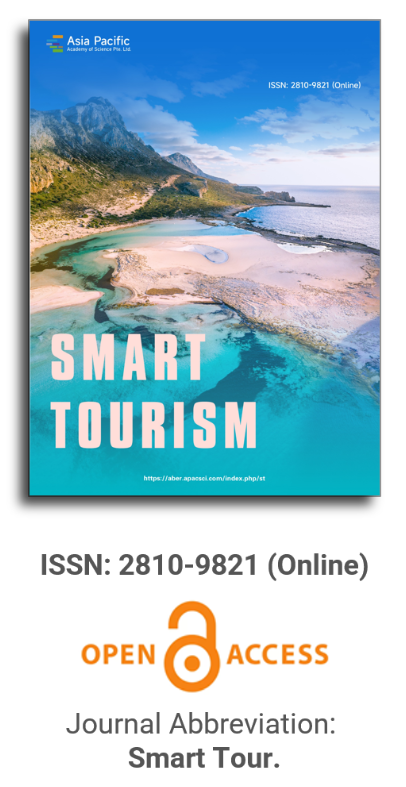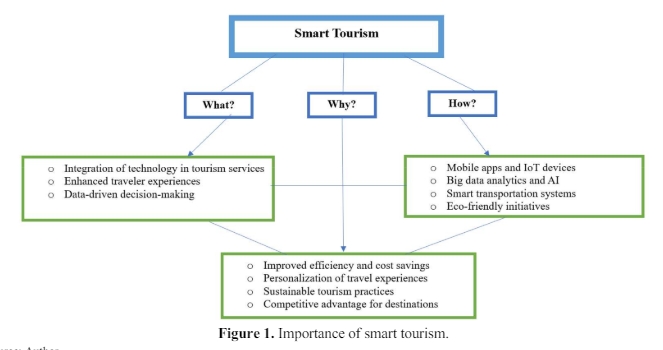
Publication Frequency
Semi-annual
Journal Articles
Search
Search scope
Volume Arrangement
Featured Articles

This commentary critically examines the integration of smart tourism technologies within the tourism and hospitality sectors, focusing on their role in enhancing tourist experiences and operational efficiencies. Through a multidisciplinary approach encompassing a literature review, case studies, and empirical data analysis, the analysis adopts a constructivist perspective to explore tourists’ subjective experiences with technology. It highlights significant personalization, efficiency, and sustainability advancements while acknowledging challenges related to digital infrastructure and privacy concerns. Advocating for a balanced and sustainable approach that respects environmental integrity and cultural heritage, the commentary concludes with recommendations for future research on the socio-economic impacts of smart tourism, ethical data usage, and the adaptation of technologies to diverse contexts. It calls for increased investment in digital infrastructure and stakeholder collaborative efforts to promote sustainable and inclusive tourism development.

The importance of the image of the tourist destination in the communication and marketing of a tourist destination is beyond doubt. For this reason, numerous studies address these issues. However, not so many do so from the perspective of the emotion the receiver feels, which is why this study deals with analyzing the emotion generated in the receiver through neuromarketing techniques and measuring the level of engagement felt. As a fundamental part of this study, we added the variable of cultural differences, both generically and specifically for gender and age. We are mainly guided by the theories of Life Cycle Theory and Generational Theory to analyze age differences. At the same time, gender differences are approached from the Gender Role Theory. The sample comprises one hundred individuals with apparent cultural differences, one sample of German origin and residence and the other of Spanish origin and residence, 50/50. We approached the study from the point of view of the emotion felt by the receiver of the message based on ten neuromarketing techniques (EGG) and ten images used by a famous tourist destination known in both countries. The results suggest that not only are there differences in the emotion felt after viewing images of a tourist destination, but that these differences are also explained by cultural background, gender, and age.
Marketing management and sustainable tourism in the Imbabura geopark, Ecuador
Article ID: 2141
Vol 3, Issue 2, 2022
DOI: https://doi.org/10.54517/st.v3i2.2141
Vol 3, Issue 2, 2022
Received: 6 July 2022; Accepted: 21 August 2022; Available online: 6 September 2022; Issue release: 30 October 2022
Download PDF
Abstract
Geoparks are resources designed to develop conservation, education, tourism, and sustainable development. This study explores the operations, marketing strategies, trends, and possible solutions to the impacts of COVID-19 in other geoparks and destinations. To obtain this information, interviews were conducted and a secondary exploratory study of scientific databases was undertaken. Actions to revitalize tourism include improving relationships between stakeholders, increasing the involvement of local communities, changing models, creating attractive tourism products, and innovating marketing strategies through technology.
Keywords
biodiversity; geopark; destination marketing; sustainable tourism
References
- Arellano Guerrón SL, Arroyo Mera DM, Carrión Albuja EA, et al. UNESCO’s global geoparks and its importance on communities’ sustainable development. Case study: “Geopark Imbabura”. SIEMBRA 2019; 6(1): 93–108.
- Lapointe D. Reconnecting tourism after COVID-19: The paradox of alterity in tourism areas. Tourism Geographies 2020; 22(3): 633–638.
- Saarinen J. Enclavic tourism spaces: Territorialization and bordering in tourism destination development and planning. Tourism Geographies 2017; 19(3): 425–437.
- Crossley É. Ecological grief generates desire for environmental healing in tourism after COVID-19. Tourism Geographies 2020; 22(3): 536–546.
- He H, Harris L. The impact of COVID-19 pandemic on corporate social responsibility and marketing philosophy. Journal of Business Research 2020; 116: 176–182.
- Wang Y, Hong A, Li X, et al. Marketing innovations during a global crisis: A study of China firms’ response to COVID-19. Journal of Business Research 2020; 116: 214–220.
- Andreou PC, Karasamani I, Louca C, et al. The impact of managerial ability on crisis-period corporate investment. Journal of Business Research 2017; 79: 107–122.
- Jiménez-Barreto J, Rubio N, Campo S, et al. Linking the online destination brand experience and brand credibility with tourists’ behavioral intentions toward a destination. Tourism Management 2020; 79: 104101.
- Naidoo V. Firm survival through a crisis: The influence of market orientation, marketing innovation and business strategy. Industrial Marketing Management 2010; 39(8): 1311–1320.
- Wen J, Kozak M, Yang S, et al. COVID-19: Potential effects on Chinese citizens’ lifestyle and travel. Tourism Review 2020; 76(1): 74–87.
- Paul Dorin B. The impacts of tourism on the physical environment. Annals of Tourism Research 1978; 17(2): 215–237.
- Lin L, Huang S, Ho Y. Could virtual reality effectively market slow travel in a heritage destination? Tourism Management 2020; 78: 104027.
- Molinillo S, Liébana-Cabanillas F, Anaya-Sánchez R, et al. DMO online platforms: Image and intention to visit. Tourism Management 2018; 65: 116–130.
- Jung TH, Tom Dieck MC. Augmented reality, virtual reality and 3D printing for the cocreation of value for the visitor experience at cultural heritage places. Journal of Place Management and Development 2017; 10(2): 140–151.
- Dimitrios B. Marketing the competitive destination of the future. Tourism Management 2000; 21(1): 97– 116.
- Merinero-Rodríguez R, Pulido-Fernández JI. Analysing relationships in tourism: A review. Tourism Management 2016; 54: 122–135.
- Graci S. Collaboration and partnership development for sustainable tourism. Tourism Geographies 2013; 15(1): 25–42.
- Wondirad A, Tolkach D, King B. Stakeholder collaboration as a major factor for sustainable ecotourism development in developing countries. Tourism Management 2020; 78: 104024.
- Ruhanen L. Local government: Facilitator or inhibitor of sustainable tourism development? Journal of Sustainable Tourism 2013; 21(1): 80–98.
- Wu H, Kim S, Wong AKF. Residents’ perceptions of desired and perceived tourism impact in Hainan Island. Asia Pacific Journal of Tourism Research 2020; 25(6): 573–591.
- Miller G. The development of indicators for sustainable tourism: Results of a Delphi survey of tourism researchers. Tourism Management 2001;22(4): 351–362.
- Choi HSC, Sirakaya E. Sustainability indicators for managing community tourism. Tourism Management 2006; 27(6): 1274–1289.
- Cheer JM. Human flourishing, tourism transformation and COVID-19: A conceptual touchstone. Tourism Geographies 2020; 22(3): 514– 524.
- Niewiadomski P. COVID-19: From temporary de-globalisation to a re-discovery of tourism? Tourism Geographies 2020; 22(3): 651–656.
- Brouder P. Reset redux: Possible evolutionary pathways towards the transformation of tourism in a COVID-19 world. Tourism Geographies 2020; 22(3): 484–490.
- Higgins-Desbiolles F. Socialising tourism for social and ecological justice after COVID-19. Tourism Geographies 2020; 22(3): 610–623.
- Stoffelen A. Where is the community in geoparks? A systematic literature review and call for attention to the societal embedding of geoparks. Area 2020; 52(1): 97–104.
- Shekhar S, Kumar P, Chauhan G, et al. Conservation and sustainable development of geoheritage, geopark, and geotourism: A case study of cenozoic successions of western Kutch, India. Geoheritage 2019; 11(4): 1475–1488.
- SingtuenV, Gałka E, Phajuy B, et al. Evaluation and geopark perspective of the geoheritage resources in Chiang Mai Area, Northern Thailand. Geoheritage 2019; 11(4): 1955–1972.
- Costa CMM, Amrikazemi A. Geo-knowledge management and geoconservation via geoparks and geotourism. Geoheritage 2014; 6: 185–192.
- United Nations Educational, Scientific and Cultural Organization (UNESCO) [Internet]. Paris: UNESCO; 2017. Available from: http://www.unesco.org/new/en/natural-sciences/environment/earth-sciences/unesco-global-geoparks/.
- Özgeriş M, Karahan F. Use of geopark resource values for a sustainable tourism a case study from Turkey (Cittaslow Uzundere). Environment, Development and Sustainability 2021; 23(3): 4270– 4284.
- Secretaría del Convenio sobre la Diversidad Biológica. Directrices sobre diversidad biológica y desarrollo del turismo (Spanish) [Guidelines on biodiversity and tourism development] [Internet]. 2004. Available from: https://www.cbd.int/doc/publications/tou-gdl-es.pdf.
- Serna A. Strategies for the sustainable and sustainable development of the Imbabura Geopark, Ecuador. Turismo & Aventura 2017; 1(3): 61–70.
- Timothy DJ. Cooperative tourism planning in a developing destination. Journal of Sustainable Tourism 1998; 6(1): 52–68.
- Lin L. Industrial tourists’ behavioral intention toward slow travel in Taiwan. Journal of Sustainable Tourism 2017; 25(3): 379–396.
- Hurley RF, Hult GTM. Innovation, market orientation, and organizational learning: An integration and empirical examination. Journal of Marketing 1998; 62(3): 42–54.
Supporting Agencies
Copyright (c) 2022 Álvaro René Pérez González, Julio César Andrade Palacios, Lenin Roberto Castro Quelal
License URL: https://creativecommons.org/licenses/by/4.0

This site is licensed under a Creative Commons Attribution 4.0 International License (CC BY 4.0).
Editor-in-Chief

Prof. Hung-Che Wu
Nanfang College, Guangzhou
China
Indexing & Archiving
News & Announcements
2025-01-09
A Thank You Letter from Smart Tourism!
As we bid farewell to 2024, we take immense pride in reflecting on the 28 distinguished works that have been meticulously published online following a rigorous peer-review process. We extend our heartfelt gratitude for authors' invaluable contributions, reviewers' steadfast support, and EBM's insightful guidance throughout the year. Your dedication and expertise have been instrumental in propelling Smart Tourism towards its current success.
2024-07-05
Call for Reading: Volume 5 Issue 1 Available
We are pleased to announce the release of Volume 5 Issue 1 of Smart Tourism. We sincerely invite researchers to download and read articles in this issue. It is hopeful that the content will bring readers new perspectives and inspire the research in related field.
2024-01-15
New layout style in 2024
In 2024, Smart Tourism will adopt a new layout style. Please turn to the "Author Guidelines" for preparing your manuscripts.
Journal Center
Asia Pacific Academy of Science Pte. Ltd. (APACSCI) specializes in international journal publishing. APACSCI adopts the open access publishing model and provides an important communication bridge for academic groups whose interest fields include engineering, technology, medicine, computer, mathematics, agriculture and forestry, and environment.



.jpg)
.jpg)

.jpg)

